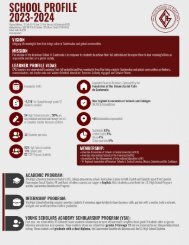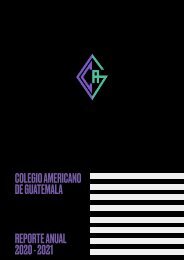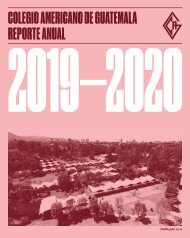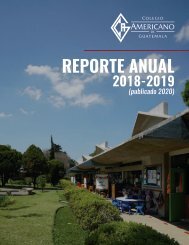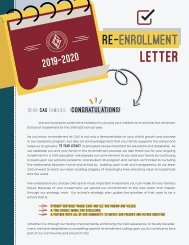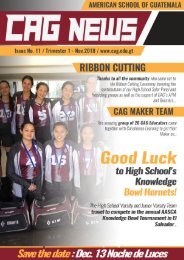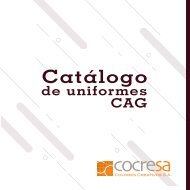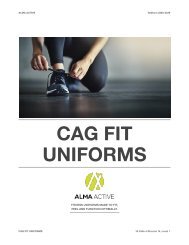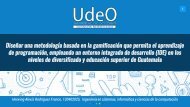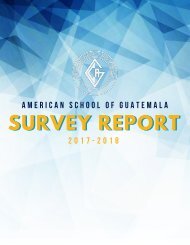CAG Together Again
Create successful ePaper yourself
Turn your PDF publications into a flip-book with our unique Google optimized e-Paper software.
2021<br />
Reimagining How We Come<br />
together<br />
again
TABLE OF<br />
CONTENTS<br />
INTRODUCTION LETTER<br />
EXECUTIVE SUMMARY<br />
3<br />
5<br />
TIMELINE 6<br />
PART 1<br />
Preparing Faculty and Staff<br />
PART 2<br />
Preparing Students<br />
PART 3<br />
Teaching and Learning Models<br />
PART 4<br />
Security Measures and Protocols<br />
7<br />
10<br />
13<br />
19<br />
ANNEX DOCUMENTS<br />
A Message About Public Health &<br />
School Preparedness<br />
What is Social Distancing?<br />
Checklist for Families<br />
Checklist for Students<br />
22<br />
23<br />
26<br />
27<br />
28
Dear <strong>CAG</strong> Faculty, Staff, Students, and Families,<br />
It’s time that we start planning our future and look forward to when we are<br />
<strong>Together</strong> <strong>Again</strong>!<br />
The American School of Guatemala is preparing for a hopeful return to school. Our<br />
return will operate in a modified format and is fully dependent upon national<br />
and local government mandates, public health guidelines (MSPAS), and Ministry<br />
of Education (MINEDUC) expectations. This means, our plans will be flexible, keeping<br />
students, faculty, and staff health and safety as our primary goal.<br />
<strong>CAG</strong> will demonstrate agility in this pandemic era and call upon its community to be<br />
well informed and supportive of the work we have ahead. Our <strong>CAG</strong> <strong>Together</strong> <strong>Again</strong><br />
Plan is developed around the premise that schools may soon be permitted to open in<br />
the months ahead. The <strong>CAG</strong> <strong>Together</strong> <strong>Again</strong> Plan is also developed to be flexible and<br />
responsive in the following ways;<br />
Open opportunities for students who need to develop social connections and regain<br />
familiarity with their school<br />
Provide <strong>CAG</strong> Virtual options for students, faculty, and staff who are unable or afraid<br />
to return to school until there are vaccinations<br />
Establish social distancing and cleaning protocols for all members of our community<br />
Support families who need to return to work<br />
Ensure the School, its academic program, and operations can pivot to follow all<br />
government mandates that may call for phasing back or periodic lockdowns.<br />
We believe that the role of the American School of Guatemala is to provide clarity and<br />
respond to uncertainty by outlining our reopening plan, we call it the <strong>CAG</strong> <strong>Together</strong><br />
<strong>Again</strong>. The plan is divided into important parts that outline our phase transition back<br />
to work and back to school.<br />
Part 1 – Preparing our Faculty and Staff to Return to Work<br />
Part 2 – Preparing our Students to Return to School (maximize space and minimize groups)<br />
Part 3 – Our Teaching and Learning Models<br />
Part 4 – Campus Operations, Facilities, Transportation, and Security<br />
3
Since the wake of the global COVID-19 pandemic, The American School of Guatemala<br />
has been navigating immediate challenges, while building a strategic perspective for<br />
the future. The <strong>CAG</strong> <strong>Together</strong> <strong>Again</strong> Plan for the 2020/2021 school year is meant to<br />
roll-out a perspective on how we will move forward and what our priorities are for<br />
our students and the entire <strong>CAG</strong> community during a time of uncertainty. Such<br />
priorities include making sure we implement and adhere to rigorous health and<br />
safety measures, design flexible and robust teaching and learning models, plan for<br />
various student schedules across all sections, ensure that the school can function<br />
and be agile around social distancing guidelines while never losing sight of our<br />
school’s mission promise---empowering students to achieve their full potential and to<br />
inspire them to lead meaningful lives. At the heart of our <strong>Together</strong> <strong>Again</strong> plan is this<br />
simple and powerful purpose.<br />
We thank the <strong>CAG</strong> community for the opportunity to partner and share the <strong>Together</strong><br />
<strong>Again</strong> Plan with you. Please know that we will be scheduling webinars for our<br />
parents, faculty, and staff in the weeks ahead, to offer an overview of the details<br />
within each of the four phases we have outlined. Aside from the webinars, you will<br />
receive details to help you and your children prepare for the new school year ahead.<br />
Finally, in a safe and healthy way and when government guidelines permit, we want<br />
to get back to school, and we want to help you get back to work. We look forward to<br />
being together again soon.<br />
In the tradition of maroon and gray,<br />
Patricia Lee Marshall<br />
General Director
Executive Summary<br />
In this document you will find...<br />
Our Plan<br />
To make our return to campus a possibility, we have elaborated on a plan that is<br />
divided into four phases. This plan and its timeline are fully dependent on<br />
government guidelines and recommendations from the Ministerio de Salud<br />
Pública y Asistencia Social (MSPAS) and the Ministerio de Educación (MINEDUC).<br />
Our Mission<br />
Being able to return to campus abiding by government and public health guidelines<br />
while ensuring the safety and well-being of our students, faculty, and staff.<br />
OUR VISION<br />
To navigate through uncertain times with a plan that allows us to comply with our<br />
value proposition and ensure a world-class education, whether it be virtual or<br />
on-site while adapting to the circumstances around us and providing certainty and<br />
security for all our stakeholders.<br />
What to expect next?<br />
We will be sending regular information updates to support our families in preparation<br />
for the start of the 2020-2021 school year.<br />
5
TIMELINE<br />
The American School of Guatemala has developed a generalized timeline to guide<br />
decisions and preparedness planning for the school community. We believe in<br />
establishing the expectations for our stakeholders so we can all work together for<br />
what is right in teaching and learning, faculty and students.<br />
Because the world has changed rapidly in the wake of COVID-19 and each week<br />
government orders, statistics, and predictions are changing, please know that<br />
timelines will alter and be adjusted accordingly.<br />
01<br />
May, 2020<br />
Surveying Work Teams<br />
Grouping Work Teams<br />
Procedures in Place<br />
02<br />
June, 2020<br />
Operational Teams<br />
Leadership, General Director Training<br />
Campus Procedures and Self Protection,<br />
Social Distancing<br />
Parent Survey Opt in/out Blended Learning<br />
03<br />
04<br />
05<br />
*<br />
*<br />
July, 2020<br />
August, 2020<br />
Enero, 2021<br />
Educational Leadership and Business Ops<br />
Faculty Return and Organized in<br />
Groups<br />
Social Distance, Protective Gear, Sanitation<br />
Training<br />
Virtual and Blended Learning Protocols<br />
Virtual Teaching and Learning Begins<br />
Specialized Groups, Transitions, and<br />
Training<br />
Hybrid School Begins<br />
Virtual School Continues<br />
Student Life & Athletics (March 2021)<br />
Modified School Begins (April 2021)<br />
* 4 and 5 Pending Government Guidelines<br />
6
PART 1<br />
PREPARING OUR FACULTY<br />
and STAFF TO<br />
RETURN TO WORK<br />
The American School of Guatemala is a large organization and employs a large staff,<br />
and is host to a complex teaching community composed of local educators and Teaching<br />
Fellows. Making sure we can respond, guide, and prepare our expert teams on campus is<br />
imperative in securing the safety of the community. They are our frontline.<br />
<strong>CAG</strong> will implement the following practices:<br />
Care and Concern; Everyone is important<br />
Daily health<br />
and wellness<br />
checks.<br />
Health and wellness<br />
response system that includes<br />
the Human Resource Office<br />
reaching out to anyone illness<br />
or a request for wellness<br />
support.<br />
Sick days are<br />
excused. Stay<br />
home if you are<br />
sick.<br />
<strong>CAG</strong> Human<br />
Resources has access<br />
to medical, counseling,<br />
& ambulance<br />
directories.<br />
<strong>CAG</strong> Human<br />
Resources<br />
supports local &<br />
ex-pat insurance<br />
questions.<br />
<strong>CAG</strong> conducts regular<br />
communications & virtual<br />
meetings with faculty and staff, to<br />
keep everyone informed of government<br />
orders and their impact on<br />
school and work operations.<br />
May survey to inquire who<br />
among our faculty & staff is<br />
at risk or has an at risk family<br />
member in order to establish<br />
a virtual work schedule.<br />
No food services on<br />
campus. Teachers<br />
are encouraged to<br />
bring food from<br />
home.<br />
Water fountains<br />
closed. Bring<br />
water bottles<br />
from home.<br />
Personal belongings stay in<br />
assigned spaces. These spaces<br />
need to be wiped each morning<br />
and each afternoon with school<br />
provided cleaner.
Civic Responsibility;<br />
Help us keep others safe<br />
Essential teams reporting to<br />
campus have protocols that include<br />
a required face mask, temperature<br />
checks, use of hand gel upon entry,<br />
& handwashing expectations<br />
throughout their workday.<br />
A small crew of staff report<br />
alternating days & times to conduct<br />
business and to monitor facilities and<br />
maintenance details. These crews<br />
have work station protocols to keep<br />
desks and equipment clean.<br />
Reporting self illness<br />
or that of a family<br />
member is an<br />
expectation with<br />
quarantine guidelines.<br />
Reporting travel<br />
and fulfilling<br />
quarantine.<br />
Some teachers<br />
commute to student<br />
classrooms.<br />
Student groups<br />
stay stationary.<br />
!<br />
Do not cluster in<br />
faculty rooms, work<br />
rooms, office spaces.<br />
8
TEAMWORK!<br />
CHECKLIST FOR SCHOOL<br />
ADMINISTRATORS, TEACHERS, AND STAFF<br />
<strong>CAG</strong> will follow these actions for prevention and contol<br />
1 2<br />
Promote and demonstrate regular<br />
hand washing and positive hygiene<br />
behaviors and monitor their uptake.<br />
Ensure adequate, clean, and separate<br />
toilets for girls and boys<br />
Ensure soap and safe water is<br />
available at age-appropriate hand<br />
washing stations<br />
Encourage frequent and thorough<br />
washing (at least 20 seconds)<br />
Place hand sanitizers in toilets,<br />
classrooms, halls, and near exits<br />
where possible to ensure adequate,<br />
clean, and separate toilets or latrines<br />
for girls and boys<br />
Clean and disinfect school buildings,<br />
classrooms, and especially water and<br />
sanitation facilities at least once a day,<br />
particularly surfaces that are touched<br />
by many people (railings, lunch tables,<br />
sports equipment, door and window<br />
handles, toys, teaching and learning<br />
aids, etc.)<br />
Use sodium hypochlorite at 0.5%<br />
(equivalent 5000ppm) for disinfecting<br />
surfaces and 70% ethyl alcohol for<br />
disinfection of small items, and ensure<br />
appropriate equipment for cleaning<br />
staff<br />
Carpets, foam floor sections, and<br />
plush toys can not be sanitized often<br />
or thoroughly enough.<br />
These items will need to be packed<br />
away during the pandemic time period.<br />
3<br />
Increase<br />
airflow and ventilation<br />
where climate allows (open<br />
windows, etc.)<br />
4<br />
Post signs encouraging good hand<br />
and respiratory hygiene practices.<br />
5<br />
F<br />
Ensure trash is removed daily and<br />
disposed of safely.<br />
120<br />
6C<br />
50<br />
Wear masks. It is mandatory.<br />
Temperature check.<br />
(Key Messages and Actions for COVID-19 Prevention and Control in Schools, World Health Organization 2020)<br />
100<br />
40
PART 2<br />
PREPARING OUR<br />
STUDENTS TO<br />
RETURN TO SCHOOL<br />
The American School of Guatemala is a student centered school. Students are<br />
not only our responsibility, but our purpose. Keeping them safe is our priority<br />
and we will lean to all stakeholders to work with us in following health and<br />
safety guidelines.<br />
In keeping students at the heart of our school, we are fully aware of the importance<br />
in caring for our community. Therefore the <strong>CAG</strong> <strong>Together</strong> <strong>Again</strong> Plan centers on<br />
Care and Concern<br />
Daily health and wellness checks through<br />
the attendance system.<br />
Support and predictability are important<br />
constants for young children. Therefore,<br />
<strong>CAG</strong> is committed to communicating plans,<br />
protocols, schedules, and information to prepare<br />
and transition young children into a school.<br />
Choice. We know students will be anxious and<br />
have fear as society phases back into the<br />
environment. Therefore <strong>CAG</strong> will survey families<br />
about their preferences; opt-in/out options for<br />
virtual and/or blended learning programs.<br />
School counselors are present to support<br />
families, students, grade levels,<br />
and sections. Educators are trained to<br />
support students.<br />
Grade level sections will be small (allow for<br />
social distancing 6 ft apart /2 mts)<br />
- 10-12 students
Grade level sections, Prek-12, will stay in<br />
assigned classrooms all day.<br />
Food services will be closed (snacks<br />
brought from home).<br />
Water fountains will be closed. Water<br />
bottles brought from home.<br />
Personal belongings stay with student<br />
(no lockers or hooks).<br />
Play, recess, and PE take place outside only &<br />
with 1 assigned grade level section at a time.<br />
Gym and pool locker rooms will be closed.<br />
Bus routes will be made smaller to adjust<br />
to alternating start and finish times.<br />
All adults will wear personal protective<br />
gear and encourage extra cleaning and<br />
hand washing routines.
Civic Responsibility<br />
Tell a parent<br />
or a teacher<br />
when you<br />
are sick.<br />
Stay home if<br />
you or a family<br />
member are not<br />
well. Sick days<br />
are excused.<br />
Do not gossip about<br />
others being sick. We<br />
all need to be aware<br />
when others are not<br />
well. But, we cannot<br />
always assume a sick<br />
person is a<br />
COVID-19 patient.<br />
Do not bully<br />
others who are<br />
sick.<br />
Wash hands<br />
frequently with<br />
soap and water<br />
or hand gel.<br />
Keep your<br />
personal<br />
belongings<br />
with you at<br />
all times.<br />
Take care of<br />
your workstation.<br />
Wash surfaces<br />
before and<br />
after use.<br />
Respect social<br />
distancing rules.<br />
Do not cluster in<br />
social areas such as<br />
bathrooms, offices,<br />
locker rooms.<br />
Wear your<br />
masks. Masks<br />
are mandatory.<br />
12
PART 3<br />
our teaching<br />
and<br />
learning models<br />
04<br />
*<br />
August<br />
Virtual Instruction Begins<br />
Specialized Groups Transitions and<br />
recieve Training<br />
05<br />
*<br />
Enero<br />
Modified School Begins<br />
Virtual School Continues<br />
*<br />
Pending Government Guidelines<br />
A Flexible Teaching and Learning Model<br />
<strong>CAG</strong> is a leader in providing a vigorous academic program that is<br />
robust with student electives and enriched with lessons that are<br />
inspiring and empowering - a program that nurtures critical<br />
thinking.<br />
In the era of the COVID-19 pandemic, <strong>CAG</strong> has swiftly transitioned to<br />
virtual teaching and learning while embodying the qualities of excellence<br />
that defines <strong>CAG</strong>.<br />
The American School of Guatemala is building a clear, comprehensive<br />
plan that is versatile and agile so that our students continue to grow<br />
and develop, but most importantly, thrive in the post COVID-19 era. All<br />
learners will have access to the <strong>CAG</strong> experience, our faculty and<br />
friends, book clubs, grade level meetings, advisory, morning meetings,<br />
and social opportunities. And all parents can join us in experiencing the<br />
journey of deep learning and innovative teaching through Parent<br />
Connects and informational webinars.
covid-19<br />
Health Scenario for School Phasing<br />
Plan A<br />
RED<br />
Pandemic escalation, demanding stronger<br />
public-health interventions<br />
Plan B<br />
ORANGE<br />
(Blended, alternating days onsite and virtual, with<br />
preparations for continued interruptions)<br />
COVID-19 still in the environment<br />
Plan C<br />
YELLOW<br />
Plan D<br />
GREEN<br />
Strong-public health response succeeds, controlling<br />
the spread<br />
Modified school, 5 days a week, alternating daily schedules<br />
(start and end time)<br />
(Full onsite program, with preparations for continued<br />
interruptions)<br />
Effective response but virus lingers or recurs requiring<br />
some physical distancing<br />
Plan A<br />
<strong>CAG</strong> Virtual (all online)<br />
The goal of <strong>CAG</strong> Virtual School is to ensure learning continues in the event of<br />
school closure. Our goal is to provide an enriching learning experience through<br />
a virtual format where the teacher facilitates the direction while students<br />
independently extend their learning, ensure continued progress toward<br />
established learning targets for all our students, and to minimize future<br />
calendar disruptions. In keeping with <strong>CAG</strong>’s commitment to exceptional education,<br />
Virtual School experiences are developed to be robust and meaningful.<br />
<strong>CAG</strong> Virtual is an all-online program, for all learners Pre K-12, and is the most<br />
flexible option for all learners during extended school closings. <strong>CAG</strong> virtual is<br />
offered as the model which allows students to complete their course of study<br />
with a combination of synchronous and asynchronous instruction with support<br />
being provided by <strong>CAG</strong> teachers-core content and specialized subject teachersat<br />
each grade level and across the content areas.
All assemblies, student life activities, and community events are modified<br />
and moved to a virtual format, including activities in counseling and<br />
student support. <strong>CAG</strong> Virtual is a comprehensive program that advances<br />
all learners through the <strong>CAG</strong> experience and designed for completion of<br />
learning standards and validation for promotions.<br />
<strong>CAG</strong> Virtual is designed to support the various ages and stages of our<br />
learners and keeps a healthy balance of screen time lessons and assignments<br />
as outlined by the Academy of American Pediatrics and the World<br />
Health Organization. The program is designed for increased independence<br />
for elementary, middle school, and high aged <strong>CAG</strong> learners. For our<br />
younger <strong>CAG</strong> students, the program does require support in managing the<br />
online tools, computer usage oversight, and to read the instructions.<br />
When implementing the <strong>CAG</strong> Virtual program, the American School of<br />
Guatemala offers parent support, workshops, and webinars to support<br />
your learners at home.<br />
Plan B<br />
Hybrid Learning<br />
(alternating days on site, alternating start times, alternating virtual days)<br />
Students will slowly phase towards campus life with alternating schedule -<br />
alternating days and alternating stop and end times. The Hybrid program is<br />
intended to offer familiarity and comfort with the school environment,<br />
allow young children to experience real-time friendships, and interactions<br />
with friends and teachers, but under strict social distancing guidelines. For<br />
the days that children are not on campus, students continue to have skills<br />
reinforced with synchronous (live instruction) and asynchronous (teacherdirected)<br />
<strong>CAG</strong> Virtual. As we have these past few months, <strong>CAG</strong> will continue<br />
with regular modifications to ensure that students are receiving a well-balanced<br />
and academically fulfilling experience.<br />
The Hybrid schedule onsite is limited to accommodate phasing restrictions<br />
and strict social distancing guidelines. Classes are kept in small cohorts,<br />
assigned to one space onsite, teachers rotate to them. Cafeteria and<br />
tienditas are closed, and gyms and locker rooms are not accessible.<br />
These protocols will be in place with carefully monitored attendance, illness<br />
reporting, and rigorous campus cleaning protocols.<br />
Students and families are surveyed to opt-in or out of this hybrid<br />
experience.
Examples of Hybrid Learning Schedule<br />
(special requests will not be considered)<br />
Prek-8 Students are divided into two(2) groups<br />
Group A (families last names A-L)<br />
Group B (Families last name M-Z)<br />
Alternating Days<br />
Group A on site Monday and Wednesday (<strong>CAG</strong> Virtual; Tues,Thurs, Fri)<br />
Group B on site Tuesday and Thursday (<strong>CAG</strong> Virtual; Mon, Wed, Fri)<br />
Fridays are alternating and Specialized (schedule to be established) and are called<br />
WIN (What I Need) Days<br />
Student Example<br />
Alternating Start and End Times<br />
7:30am-12:00pm<br />
10:00am-2:30pm<br />
Student Garcia Kindergarten Monday and Wednesday 7:30am-12:00pm<br />
Student Perez 4th grade Monday and Wednesday 10:00am-2:30pm<br />
Student Suarez 6th grade Tuesday and Thursday 7:30am-12:00pm<br />
*All other days will be <strong>CAG</strong> virtual<br />
High School Groupings<br />
Group A (grades 9-11)<br />
Group B (grades 10-12)<br />
Student Alvarez 11th grade Tuesday and Thursday 10:00am-2:30pm<br />
16
Plan C<br />
A modified on Campus Learning<br />
<strong>CAG</strong> moves to this phase assuming that conditions, as established by local government,<br />
are safe for a full onsite return. The American School of Guatemala is fully aware that if<br />
and when we are ready for a full onsite experience, we will need to prepare our faculty,<br />
staff, students, and families, into a careful transition with modified schedules to support<br />
the safety, health, and well being of the community. We will also continue to leave this as<br />
an Opt-in for our families, should they be fearful or have high-risk health concerns in their<br />
home.<br />
In this Step 3 process, The American School of Guatemala will be prepared to fully<br />
transition to <strong>CAG</strong> Virtual in the event our community experiences a spike in COVID-19<br />
cases and the Guatemalan Government calls for interruption of onsite instruction. Specific<br />
decisions and plans regarding on-campus modifications will be finalized over the next few<br />
months.<br />
This modified approach to onsite learning will have alternating pick-up and drop off times<br />
for controlled crowds of students and faculty. Onsite athletic offerings will initiate in the<br />
step 3 program with modified schedules for practices only (no competitive matches).<br />
After school enrichment and extended day programming will likely be offered for students<br />
in grades 8-12 with social distancing expectations.<br />
We believe we will still experience school closures throughout the year, and even at Step<br />
3, please expect long closures. We will offer virtual enrichment activities for younger<br />
students.<br />
Because the world has changed rapidly in the wake of COVID-19 this information is<br />
subject to change.<br />
Teaching &<br />
Learning<br />
Campus Instruction Start End Cafeteria Athletics Student<br />
Time<br />
Tienda<br />
Life<br />
WIN<br />
<strong>CAG</strong><br />
Virtual<br />
No<br />
4.5<br />
8:00 12:30<br />
No<br />
Virtual<br />
Modified<br />
Virtual<br />
Modified<br />
Built in<br />
Virtually<br />
Blended<br />
2 days<br />
a week<br />
4.5<br />
Alternate<br />
7:30<br />
10:00<br />
Alternate<br />
12:00<br />
2:30<br />
No<br />
Modified<br />
Virtual<br />
Modified<br />
Fridays<br />
or 2:30<br />
Modified<br />
5 days<br />
4.5<br />
Alternate<br />
7:30<br />
10:00<br />
Alternate<br />
12:00<br />
2:30<br />
Modified<br />
MS/HS<br />
Modified<br />
Onsite<br />
Fridays<br />
2:30<br />
<strong>CAG</strong> Full<br />
Session<br />
6.5<br />
7:30 2:00 Yes All All<br />
5 days Built in
win days!<br />
(What I Need)<br />
The American School of Guatemala is a student-centered school. It firmly believes that<br />
students are both inspired and empowered when teachers and parents come together<br />
to celebrate, honor, and support learners finding and presenting unique ways to meet<br />
their needs within the robust academic program established by the school.<br />
What I Need (WIN) Days are unique opportunities for students to have direct support<br />
from learning specialists, counselors, advisors, Deans, the College Office, etc. . . in<br />
blended and modified schedules.<br />
These may be scheduled by the school, by the student, and by the<br />
specialist on campus as personalized check-ins.<br />
How do we know when to<br />
employ which step?<br />
YES<br />
GUATEMALAN<br />
GOVERNMENT<br />
LIFTS THE SCHOOL<br />
CLOSURE<br />
MANDATE<br />
As a family, you have determined that you<br />
are comfortable with your children returning to<br />
the physical campus. Survey and release form.<br />
<strong>CAG</strong> Virtual<br />
(all virtual)<br />
Hybrid<br />
Learning<br />
Your child(ren) will<br />
return after winter<br />
recess, January 2021<br />
to an on campus hybrid<br />
program with modified<br />
schedules and shorter<br />
days.<br />
NO<br />
18
PART 4<br />
Campus operations,<br />
facilities, transportation,<br />
and security<br />
Entering Campus Check-in Points<br />
Bus (am and pm)<br />
Pasarela<br />
Puerta Norte<br />
Please note, Kinder Gate (UVG Gate) will not be<br />
open for teachers, faculty or staff to enter or leave<br />
campus.<br />
Temperature Check<br />
We will record faculty, staff,<br />
student, and visitors'<br />
temperature upon their entry<br />
to campus.<br />
F 97-99 (>99.5 not permitted)<br />
C 36.5-37.5 (>37.5 not permitted)<br />
F<br />
C<br />
120<br />
50<br />
F 99.5<br />
Not permitted<br />
onto campus<br />
100<br />
80<br />
40<br />
30<br />
C 37.5<br />
Not permitted<br />
onto campus<br />
60<br />
20
40<br />
10<br />
20<br />
0<br />
0<br />
10<br />
20<br />
20<br />
40<br />
30<br />
60<br />
40<br />
VISITORS - Covid19 Visitor Protocol<br />
1<br />
2<br />
3<br />
4<br />
5<br />
6<br />
7<br />
8<br />
9<br />
Visitors must have a scheduled and approved appointment and registered at the security gate for admittance<br />
to the campus. Upon scheduling the appointment, <strong>CAG</strong> will give these guidelines to the visitor.<br />
Identification can be shown (not passed to) to the guard. It will be documented. This takes time.<br />
All visitors must enter through the main gate. Report any illness or illness at home. If illness is reported or<br />
suspected, the visitor will be denied entrance. Report any travel outside the department and/or country.<br />
Visitors will not be permitted to enter if traveled in the last 14 days.<br />
All visitors must have a mask. No mask, no entrance.<br />
All visitors will have a temperature check. If the temperature is<br />
F 97-99 (>100 not permitted) C 36.5-37.5 (>37.5 not permitted)<br />
Each visitor will use hand gel.<br />
Operations visitors will be provided disposable gloves if delivering or picking up<br />
cargo or shipments of any kind. These visitors are not permitted to use their own gloves.<br />
Each visitor will be directed to wait in the central hall (Reception) of the school until<br />
met by the campus host.<br />
All visitors will respect social distancing guidelines. No physical greeting hosts, acquaintances or students.<br />
This is a dynamic situation and it is likely that things will continue to change. We will continue to issue new<br />
information and guidance as appropriate.<br />
Service provider visits will be arranged after school hours.
Transportation and Bus Routes<br />
The American School of Guatemala has its own fleet of buses, drivers, and monitors.<br />
Our team of drivers and monitors are trained to clean and sanitise the buses<br />
between routes, to protect themselves and others with school staff and faculty<br />
protocols (masks, frequent hand washing and gel, no touching face, reporting illness,<br />
and staying home). The American School of Guatemala has also organized routing to<br />
respect social distance guidelines.<br />
Drivers and monitors wear masks.<br />
Conduct frequent handwashing and use of hand gel.<br />
Hand gel is kept on the bus and students will receive a dose upon<br />
entering and exiting the bus.<br />
We will record student temperature check upon entering the bus<br />
F 97-99 (>100 not permitted)<br />
C 36.5-37.5 (>37.5 not permitted)<br />
Conduct high touch audits (doors, handles, steering wheel, seats, child<br />
safety seats, railings, floors, etc. )<br />
Use school approved disinfectant cleaner to clean surfaces before,<br />
after, and between routes. Alternating start and end times to support<br />
social distancing spacing on the buses.<br />
Routes are assigned drivers, students, monitors, and buses.<br />
Buses are logged daily to an assigned route.<br />
The school will only charge fees for services rendered. Prices will be<br />
prorated for daily use only.
Medical Clinic<br />
The Medical Clinic is to attend to students, faculty, and staff. Its main<br />
priority is students.<br />
The Medical Clinic is a center for triage. The role of the doctor and<br />
nurse on campus is to respond to emergencies, assess immediate<br />
concerns, and make recommendations. The doctor or nurse does not<br />
diagnose student or adult illnesses.<br />
The Medical Clinic records and collects data on all visits to the office.<br />
The doctor and nurse follow school policies and will require that<br />
students with fever, vomit, or any suspected contagion will need to<br />
stay in the office and be picked up immediately.<br />
The doctor and the nurse have reporting protocols to the General<br />
Director, the Crisis Management Team (CMT), and to the local<br />
authorities should we suspect there is a contagion on campus.<br />
reporting and campus protocols<br />
<strong>CAG</strong> expects all members (students, faculty, and staff) of the school to report<br />
their illnesses and stay home, follow doctors' orders, and do not return until<br />
you have clearance from a medical professional to do so.<br />
When brought to our attention, illness and contagions are reported to the<br />
potentially infected student groups (like we would for flu, strep throat,<br />
conjunctivitis, etc.) If sick on campus, students must report to room CE-25 for<br />
isolation.<br />
<strong>CAG</strong> has a campus doctor and nurse. These professionals do not diagnose.<br />
In the case of COVID-19 they are part of the immediate response team, who<br />
will support the school in proper reporting to all authorities.<br />
During the COVID-19 pandemic, and in preparing for phasing back to<br />
business and operations, students who chose onsite learning will be in<br />
classes between 10-12 students. These students are assigned to a classroom<br />
and a group of teachers. They do not leave the classroom and teachers<br />
report to them. Each physical space has a student and faculty, staff contact<br />
inventory so we can isolate exposure and communicate swiftly.<br />
covid-19 <strong>CAG</strong> Health and Safety Protocols<br />
Entering<br />
campus &<br />
managing<br />
campus<br />
visitors<br />
Personal<br />
protective gear<br />
& workstation<br />
cleaning<br />
expectations<br />
Social<br />
distancing on<br />
campus, at work,<br />
and in the<br />
classrooms<br />
Developing<br />
alternating work<br />
teams across all<br />
departments &<br />
sections<br />
Reporting<br />
protocols and<br />
communicating<br />
illness
documents
A Message about<br />
Public Health and School Preparedness<br />
The COVID-19 pandemic has emphasized the importance of being flexible and<br />
responsive in all situations, and especially in navigating through uncertainty. The<br />
School is a leader in situational planning and in safeguarding the health and<br />
wellness of its students, its faculty, and its staff.<br />
The American School of Guatemala is preparing different scenarios to continue to<br />
operate school in various formats that include virtual and/or a modified (blended)<br />
onsite approach, while also continuing to prepare to transition the school and its<br />
operations back to an all virtual format should extended interruptions continue to<br />
be imposed.<br />
Discussions about phasing from a virtual program to a modified (blended) onsite<br />
program will only commence upon government orders and guidelines and upon<br />
assuring the School meets the safety, sanitization, and social distancing protocols<br />
necessary for the health and safety of the <strong>CAG</strong> community.<br />
How do we know when to transition to these different scenarios?<br />
We first review the status of Guatemala’s public health and<br />
government issued guidelines.<br />
Assuming there are four levels of public health activity<br />
Wide spread of COVID-19 in the environment<br />
R<br />
E<br />
D<br />
Follow government and official lockdown orders<br />
Interruption of onsite programs<br />
Implement virtual teaching and learning<br />
Implement only essential onsite operations<br />
Spread is controlled but still in the environment<br />
O<br />
R<br />
A<br />
N<br />
G<br />
E<br />
Government has started phasing business activity and permits the expansion<br />
of operations on site, including administrative personnel, and allows for phasing<br />
of schools with strict social distancing guidelines (<strong>CAG</strong> Hybrid or Modified)<br />
Virtual learning is still an option for students (<strong>CAG</strong> Virtual)<br />
Strict social distancing<br />
Hygiene awareness, masks, and temperature checks<br />
Campus cleansing<br />
Strict attendance procedures<br />
Restricted campus visiting procedures<br />
Alternative option for those employees in high risk category
Spread is demonstrating a decrease in activity<br />
Y<br />
ELL<br />
O<br />
W<br />
Government allows for phasing of schools with strict social distancing guidelines<br />
Hygiene awareness, masks, and temperature checks<br />
Modified faculty and student schedules with partial week and partial day activity<br />
Campus cleansing<br />
Limited transportation for personnel<br />
Restricted campus visiting procedures<br />
Strict attendance and health checks<br />
Plan for when student/employees get sick<br />
Reported illness requires that campus shuts down with thorough cleaning and<br />
transition to virtual teaching and learing.<br />
No active spread<br />
G<br />
R<br />
E<br />
E<br />
N<br />
Government allows for phasing of schools with strict social distancing guidelines<br />
Hygiene awareness, masks, and temperature checks<br />
Modified student schedules alternating daily schedules<br />
Campus cleansing<br />
Transportation with social distancing and alternating routes<br />
Strict attendance and health checks<br />
Plan for when student/employees get sick<br />
Reported illness requires that campus shuts down with thorough cleaning and<br />
transition to virtual teaching and learning<br />
Restricted campus visiting procedures
The chart below, developed by the Centers for Disease Control (CDC)<br />
is a guide for the American School of Guatemala in decision making.<br />
cdc.gov/coronavirus<br />
SCHOOLS DURING THE COVID-19 PANDEMIC<br />
The purpose of this tool is to assist administrators in making (re)opening decisions regarding K-12 schools during<br />
the COVID-19 pandemic. It is important to check with state and local health officials to determine the most<br />
appropriate actions while adjusting to meet the unique needs and circumstances of the local community.<br />
Should you consider opening?<br />
Will reopening be consistent with applicable state and local orders?<br />
Is the school ready to protect children and employees at higher risk<br />
for severe illness?<br />
Are you able to screen students and employees upon arrival for<br />
symptoms and history of exposures?<br />
Are recommended health and<br />
safety actions in place?<br />
Promote healthy hygiene practices such as hand washing and<br />
employees wearing a cloth face covering, as feasible<br />
Intensify cleaning, desinfection, and ventilation<br />
Encourage social distancing through increased spacing, small<br />
groups, if feasable<br />
Train all employees on health and safety protocols<br />
Is ongoing monitoring in place?<br />
ALL<br />
YES<br />
ALL<br />
YES<br />
Develop and implement procedures to check for signs and symptoms<br />
of students and employees daily upon arrival, as feasible<br />
ANY<br />
NO<br />
ANY<br />
NO<br />
DO NOT<br />
OPEN<br />
MEET<br />
SAFEGUARDS<br />
FIRST<br />
Encourage anyone who is sick to stay home<br />
Plan for if students or employees get sick<br />
Communicate and monitor developments with local authorities,<br />
employees, and families regarding cases, and updates to polices<br />
Monitor student & employee absences and have flexible leave polices<br />
ANY<br />
NO<br />
MEET<br />
SAFEGUARDS<br />
FIRST<br />
ALL<br />
YES<br />
OPEN AND MONITOR
Social<br />
istancing?<br />
What is<br />
6 ft 6 ft 6 ft<br />
According to the CDC, social distancing,<br />
also called “physical distancing,” means<br />
keeping space between yourself and other<br />
people outside of your home. To practice<br />
social or physical distancing:<br />
Stay at least 6 feet (about 2 arms’ length)<br />
from other people<br />
Do not gather in groups<br />
Stay out of crowded places and avoid mass<br />
gatherings<br />
27
TEAMWORK!<br />
CHECKLIST FOR FAMILIES<br />
<strong>CAG</strong> will follow these actions for prevention and control<br />
1 2<br />
Monitor your child’s health and<br />
keep them home from school if<br />
they are ill.<br />
3<br />
Encourage<br />
?<br />
?<br />
your children to ask<br />
questions and express their feelings<br />
with you and their teachers.<br />
Remember that your child may have<br />
different reactions to stress; be<br />
patient and understanding.<br />
Teach and model good hygiene<br />
practices for your children:<br />
Wash your hands with soap and safe<br />
water frequently. If soap and water are<br />
not readily available, use an alcoholbased<br />
hand sanitizer with at least 60%<br />
alcohol. Always wash hands with soap<br />
and water, if hands are visibly dirty<br />
Ensure that safe drinking water is<br />
available and toilets or latrines are<br />
clean and available at home<br />
Ensure waste is safely collected, stored<br />
and disposed of<br />
Cough and sneeze into a tissue or your<br />
elbow and avoid touching your face,<br />
eyes, mouth, and nose<br />
4<br />
Prevent<br />
stigma by using facts and<br />
reminding students to be<br />
considerate of one another.<br />
5<br />
Coordinate<br />
with the school to receive<br />
information and ask how you can<br />
support school safety efforts (though<br />
parent-teacher committees, etc.)<br />
(Key Messages and Actions for COVID-19 Prevention and Control in Schools, World Health Organization 2020)
Checklist for<br />
STUDENTS<br />
(Key Messages and Actions for COVID-19 Prevention and Control<br />
in Schools, World Health Organization 2020)<br />
In a situation like this it is<br />
normal to feel sad, worried,<br />
confused, scared, or angry.<br />
Know that you are not alone<br />
and talk to someone you trust,<br />
like your parent or teacher so<br />
that you can help keep yourself<br />
and your school safe and<br />
healthy.<br />
Ask questions, educate<br />
yourself, and get information<br />
from reliable sources.<br />
Protect yourself and<br />
others. Wash your<br />
hands frequently,<br />
always with soap and<br />
water for at least 20<br />
seconds.<br />
Remember to not<br />
touch your face.<br />
Do not share cups,<br />
eating utensils, food,<br />
or drinks with others.<br />
MASKS<br />
Be a leader in keeping<br />
yourself, your school, family,<br />
and community healthy.<br />
Share what you learn about<br />
preventing disease with your<br />
family and friends, especially<br />
with younger children.<br />
Model good practices such<br />
as sneezing or coughing into<br />
your elbow and washing<br />
your hands, especially for<br />
younger family members.<br />
Don’t stigmatize your<br />
peers or tease anyone<br />
about being sick; remember<br />
that the virus doesn’t<br />
follow geographical<br />
boundaries, ethnicities,<br />
age, ability, or gender.<br />
According to CDC recommendations, children 2 years and older should wear a<br />
cloth face covering their nose and mouth when in the community setting. This<br />
is an additional public health measure people should take to reduce the<br />
spread of COVID-19 in addition to social distancing, frequent hand cleaning,<br />
and other preventive actions. A cloth face covering is not intended to protect<br />
the wearer, but may prevent the spread of virus from the wearer to others.<br />
This would be especially important in the event that someone is infected but<br />
does not have symptoms.<br />
Tell your<br />
parents,<br />
another family<br />
member, or a<br />
caregiver if<br />
you feel sick,<br />
and ask to<br />
stay home.
together<br />
again




